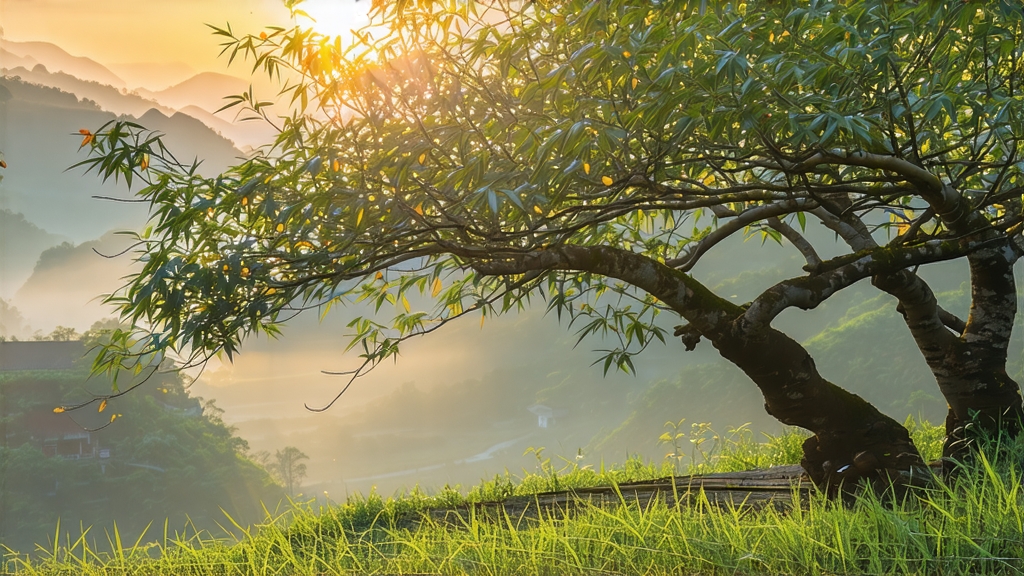
Tucked away in the cloud-veiled peaks of Sichuan’s Mengding Mountain, Mengding Huangya has been quietly perfecting its golden character for more than twelve centuries. Foreign drinkers often greet yellow tea with blank stares, assuming it is merely “mild green tea,” yet one sip of Mengding Huangya corrects the misconception: the liquor glows like late-afternoon sunlight, the aroma drifts between fresh orchid and toasted sesame, and the taste lingers with a sweetness that seems to arrive only after the cup is empty. To understand how a tea once reserved for Tang-dynasty emperors can still taste alive today, we must follow the bud from myth-covered slopes to the gaiwan in your kitchen.
Legend places the first plucking in 53 BCE, when tea ancestor Wu Lizhen planted seven bushes on the summit of Mengding, an act so sacred that local governors later decreed the leaves imperial tribute. Historical records from the Tang (618-907) and Song (960-1279) courts list “Mengding Sweet Dew” among the nation’s nine most coveted teas, and Ming-era (1368-1644) taxation scrolls quantify its value in bolts of silk and ounces of silver. When the Qing emperors shifted their palate to fragrant green teas, Mengding Huangya lost its bureaucratic patronage and retreated into monastic farms, surviving only because monks valued its meditative clarity. The 1950s revival led by master Chen Shuliang rediscovered the sealed-yellowing technique, and today the tea enjoys Protected Geographical Indication status, ensuring that only buds plucked within the 13.2 km² core zone may bear the name.
Mengding Huangya is not a single garden but a stylistic family. The top grade, “Imperial Bud,” consists entirely of unopened needles plucked in the first ten days of March, when the leaf-to-stem ratio reaches 95 % tenderness. The second grade, “Golden Tip,” allows one tiny leaf attached to the bud, while the third, “Fragrant Yellow,” includes two leaves and requires a longer withering phase to concentrate aromatics. All grades share the same micro-terroir: elevation between 800–1,450 m, annual rainfall of 1,800 mm, and a perpetual cloud cover that filters UV light, forcing the plant to synthesize more theanine and fewer bitter catechins. The soil is a crumbly yellow loam rich in selenium, a trace element that amplifies sweetness and underlies the tea’s signature “selenium snap,” a tingling sensation on the sides of the tongue.
Crafting Mengding Huangya is a choreography of heat, moisture, and patience that unfolds over four days. Picking begins at dawn when the mountain dew is still cool; any later and the sun would awaken enzymes that turn the bud grassy. The freshly plucked needles are spread on bamboo trays for three hours of shade withering, reducing moisture to 68 % and allowing a faint grassy note to evaporate. Next comes the “killing-green” step, unique among yellow teas for its gentleness: the leaves are tossed for only 90 seconds in woks held at 140 °C, just enough to halt oxidative enzymes while preserving a faint emerald heart. The pivotal act is sealed yellowing, men-huang in Chinese. The partially dried buds are wrapped in thick cotton cloth and placed inside a pine-wood chamber maintained at 28 °C and 75 % humidity for 48 hours. During this sauna-like rest, chlorophyll quietly degrades into pheophytin, polyphenols oxidize just 5–7 %, and a veil of golden down appears on the bud—visual proof that the “yellowing” chemistry has succeeded. A final low-temperature bake at 60 °C for two hours locks in the color and reduces moisture to 5 %, rendering the tea shelf-stable yet still alive with latent enzymes that will deepen its personality during careful aging.
Western brewers often treat yellow tea like a fragile green, scorching the leaves with boiling water and wondering why the cup tastes flat. Mengding Huangya demands a softer approach. Use 3 g of buds per 150 ml vessel—ideally a tall glass or a thin-walled gaiwan so you can watch the needles stand upright like miniature golden spears. Water should be spring-quality and 85 °C; hotter temperatures extract an astringent quercetin edge, while cooler water leaves the floral volat